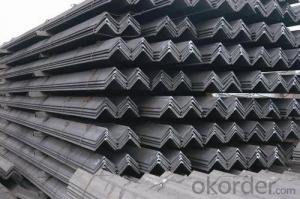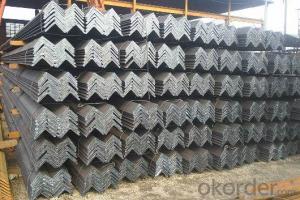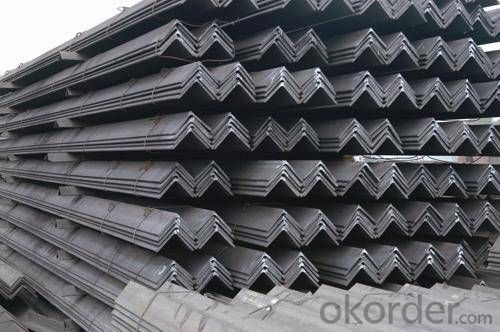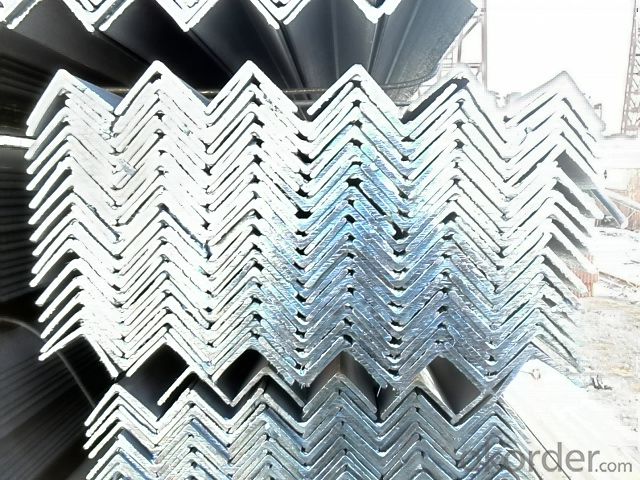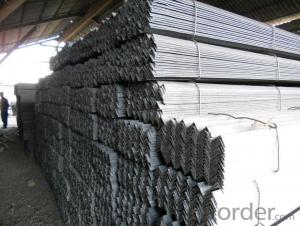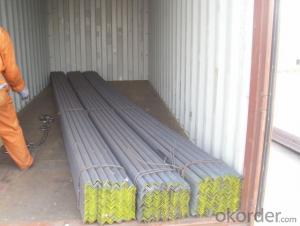Equal Steel Angles in Material Grade GB-Q235
- Loading Port:
- Tianjin
- Payment Terms:
- TT OR LC
- Min Order Qty:
- 25 m.t
- Supply Capability:
- 10000 m.t/month
OKorder Service Pledge
OKorder Financial Service
You Might Also Like
Product Description:
OKorder is offering high quality Hot Rolled Equal Angle Steel at great prices with worldwide shipping. Our supplier is a world-class manufacturer of steel, with our products utilized the world over. OKorder annually supplies products to European, North American and Asian markets. We provide quotations within 24 hours of receiving an inquiry and guarantee competitive prices.
Product Applications:
Hot Rolled Equal Angle Steels are ideal for structural applications and are widely used in the construction of buildings and bridges, and the manufacturing, petrochemical, and transportation industries.
Product Advantages:
OKorder's Hot Rolled Equal Angle Steels are durable, strong, and resist corrosion.
Main Product Features:
· Premium quality
· Prompt delivery & seaworthy packing (30 days after receiving deposit)
· Corrosion resistance
· Can be recycled and reused
· Mill test certification
· Professional Service
· Competitive pricing
Product Specifications:
Manufacture: Hot rolled
Grade: Q195 – 235
Certificates: ISO, SGS, BV, CIQ
Length: 6m – 12m, as per customer request
Packaging: Export packing, nude packing, bundled
EQUAL ANGLES SIZES |
| ||
a(mm) | a1(mm) | thickness(mm) | length |
25 | 25 | 2.5---3.0 | 6M/12M |
30 | 30 | 2.5---4.0 | 6M/12M |
38 | 38 | 2.5 | 6M/12M |
38 | 38 | 3.0---5.0 | 6M/12M |
40 | 40 | 3.0---6.0 | 6M/12M |
50 | 50 | 3 | 6M/12M |
50 | 50 | 3.7---6.0 | 6M/9M/12M |
60 | 60 | 5.0---6.0 | 6M/9M/12M |
63 | 63 | 6.0---8.0 | 6M/9M/12M |
65 | 65 | 5.0---8.0 | 6M/9M/12M |
70 | 70 | 6.0---7.0 | 6M/9M/12M |
75 | 75 | 5.0---10.0 | 6M/9M/12M |
80 | 80 | 6.0---10.0 | 6M/9M/12M |
90 | 90 | 6.0---10.0 | 6M/9M/12M |
100 | 100 | 6.0---12.0 | 6M/9M/12M |
120 | 120 | 8.0-12.0 | 6M/9M/12M |
125 | 125 | 8.0---12.0 | 6M/9M/12M |
130 | 130 | 9.0-12.0 | 6M/9M/12M |
140 | 140 | 10.0-16.0 | 6M/9M/12M |
150 | 150 | 10---15 | 6M/9M/12M |
160 | 160 | 10---16 | 6M/9M/12M |
180 | 180 | 12---18 | 6M/9M/12M |
200 | 200 | 14---20 | 6M/9M/12M |
FAQ:
Q1: Why buy Materials & Equipment from OKorder.com?
A1: All products offered byOKorder.com are carefully selected from China's most reliable manufacturing enterprises. Through its ISO certifications, OKorder.com adheres to the highest standards and a commitment to supply chain safety and customer satisfaction.
Q2: What makes stainless steel stainless?
A2: Stainless steel must contain at least 10.5 % chromium. It is this element that reacts with the oxygen in the air to form a complex chrome-oxide surface layer that is invisible but strong enough to prevent further oxygen from "staining" (rusting) the surface. Higher levels of chromium and the addition of other alloying elements such as nickel and molybdenum enhance this surface layer and improve the corrosion resistance of the stainless material.
Q3: The products are invoicing on theoritical weight or on actual weight?
A3: We can do it in both manners, according to the customers' request.
Images:
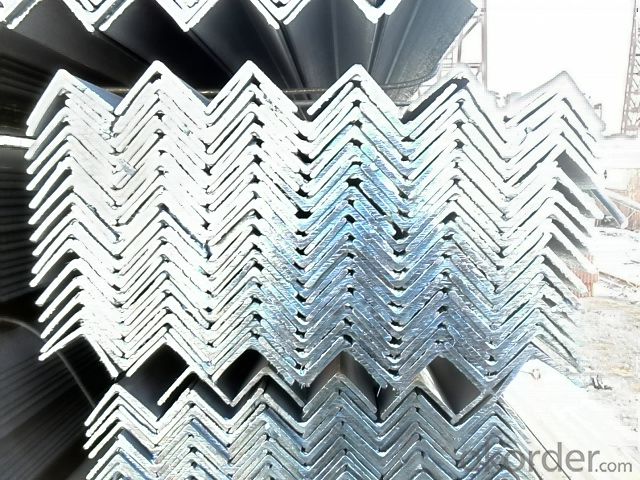
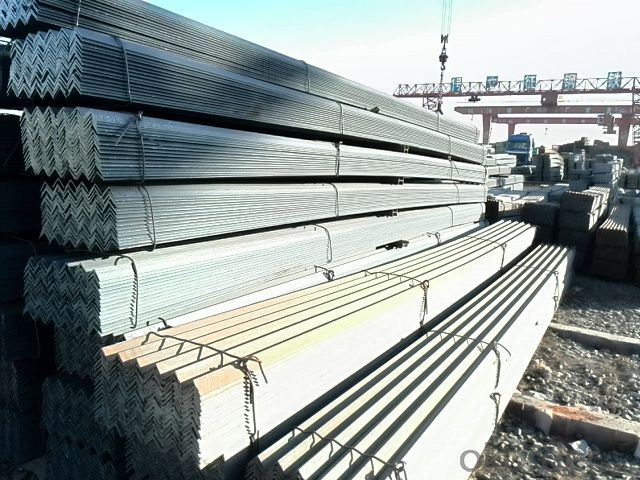
- Q: What is the difference between equal and unequal steel angles?
- Equal and unequal steel angles are structural steel components that are commonly used in construction and industrial applications. The main difference between these two types of angles lies in their dimensions and properties. Equal steel angles, also known as L-shaped angles, have equal sides and equal angles between them. They are typically used to provide support and stability in various structures, such as buildings, bridges, and machinery. The equal sides of these angles allow for symmetrical distribution of load and provide balanced strength in all directions. This makes them ideal for applications where equal support is required on both sides. On the other hand, unequal steel angles have different side lengths and different angles between them. These angles are used when there is a need for uneven load distribution or when a specific angle is required for a particular application. The longer side of the angle is typically used for load-bearing purposes, while the shorter side may be used for additional support or as a connection point. Unequal angles are commonly used in the construction of frames, brackets, and supports where unequal load distribution is expected. In terms of properties, both equal and unequal steel angles are made from carbon steel, which provides good strength and durability. These angles are typically hot-rolled or cold-formed, depending on the manufacturing process. Hot-rolled angles are produced at high temperatures, resulting in a rough surface finish but improved mechanical properties. Cold-formed angles, on the other hand, are made by bending and shaping the steel at room temperature, resulting in a smoother surface finish but slightly lower mechanical properties. In summary, the main difference between equal and unequal steel angles lies in their dimensions and load distribution capabilities. Equal angles have equal sides and are used for symmetrical load distribution, while unequal angles have different side lengths and are used for uneven load distribution or specific angle requirements. Both types of angles are made from carbon steel and are commonly used in construction and industrial applications.
- Q: What is 4# angle iron? What are the classifications of angle iron? What are the specifications? Thank you
- 4# angle steel refers to both sides are 4 cm wide, the thickness of 4 mm angle iron.Angle steel has national standard, that is, the width of both sides is equal, the thickness is width 1/10, the length is usually 6 meters.
- Q: Can steel angles be used in the construction of oil refineries?
- Yes, steel angles can be used in the construction of oil refineries. Steel angles are commonly used in construction projects due to their high strength and durability. They provide structural support and are suitable for various applications, including the construction of oil refineries. The angles can be used to create frameworks, supports, and bracing for different components and equipment within the refinery. They offer stability and resistance to heavy loads and harsh environments, which is essential in the oil refining industry. Additionally, steel angles can be easily welded, bolted, or connected to other steel members, making them a versatile choice for refinery construction.
- Q: Are steel angles available in pre-galvanized form?
- Steel angles are indeed available in a pre-galvanized state. Before being shaped into angles, these steel angles have been coated with a layer of zinc. This particular coating serves as a shield against corrosion, which makes pre-galvanized steel angles highly suitable for outdoor and high-moisture environments. Moreover, the pre-galvanized coating enhances the aesthetics of the steel angles, imparting a shiny and metallic look. Due to their strength, durability, and ability to resist corrosion, pre-galvanized steel angles find wide usage in construction, infrastructure projects, and various industrial applications.
- Q: What are the different types of surface finishes available for steel angles?
- There are several types of surface finishes available for steel angles, including hot-dip galvanized, painted, mill finish, and blackened.
- Q: What are the different finishes available for steel angles?
- Steel angles can be finished in various ways, depending on the desired appearance and level of protection. One popular option is hot-dip galvanizing, where the angle is immersed in molten zinc to create a corrosion-resistant coating. This finish is ideal for outdoor use or in environments with high humidity or exposure to chemicals. Another choice is powder coating, which involves applying a dry powder to the angle and then baking it in an oven to create a durable finish. Powder coatings come in a wide range of colors and textures, allowing for customization to meet specific design needs. They also provide good corrosion resistance and are commonly used in architectural and decorative applications. For a more natural look, the angle can be left untreated or given a mill finish. The mill finish refers to the smooth, slightly reflective appearance that occurs during the manufacturing process. This finish is often used in structural applications where aesthetics are not the main concern. Lastly, the angle can be painted or coated with enamel. This involves applying a liquid paint or enamel coating to the surface, providing both rust protection and an improved appearance. Painted finishes come in various colors and can be tailored to specific design requirements. Ultimately, the choice of finish for steel angles depends on factors such as the desired level of corrosion resistance, aesthetic preferences, and the specific application or environment in which the angles will be used.
- Q: Can steel angles be used in HVAC ductwork?
- Yes, steel angles can be used in HVAC ductwork. Steel angles are commonly used in ductwork to provide structural support and reinforcement. They are typically used at corners and joints to strengthen the ductwork and maintain its shape. Steel angles are durable, strong, and resistant to corrosion, making them suitable for use in HVAC ductwork systems. Additionally, steel angles can be easily welded or fastened together, allowing for easy installation and customization. Overall, steel angles are a reliable and commonly used component in HVAC ductwork systems.
- Q: What are the advantages of using steel angles?
- There are several advantages of using steel angles. Firstly, steel angles provide excellent structural support due to their high strength and durability. They can withstand heavy loads and extreme weather conditions, making them ideal for construction projects. Additionally, steel angles are versatile and can be easily fabricated, cut, and welded to meet specific design requirements. They are also cost-effective, as they have a long lifespan and require minimal maintenance. Lastly, steel angles offer great aesthetic appeal, making them a popular choice for architectural applications.
- Q: Are steel angles resistant to earthquakes?
- Steel angles can provide some level of resistance to earthquakes. Steel is known for its high strength and ductility, making it a suitable material for seismic-resistant construction. Steel angles, also known as steel L-shaped beams, are often used in structural applications to provide support and reinforcement. During an earthquake, steel angles can help distribute the seismic forces evenly throughout the structure, thereby reducing concentrated stress points. The L-shape design of steel angles enables them to resist bending and twisting forces, which are common during seismic events. Additionally, steel angles can be interconnected and welded together to form a rigid frame system, enhancing their seismic resistance. This system can absorb and dissipate energy from earthquake-induced vibrations, minimizing damage to the structure. However, it is important to note that the overall seismic resistance of a structure depends on various factors, such as the design, construction methods, and adherence to building codes and regulations. Steel angles alone cannot guarantee complete protection against earthquakes, but when properly integrated into a well-designed seismic-resistant system, they can significantly enhance the structure's ability to withstand seismic forces.
- Q: How do you inspect and measure the dimensions of a steel angle?
- To inspect and measure the dimensions of a steel angle, you can use various tools and techniques. Firstly, you can visually examine the angle to ensure it is free from any visible defects or deformities. Next, you can use a tape measure or calipers to accurately measure its length, width, and thickness. Additionally, a protractor can be used to measure the angle's degree of bend. To ensure precise measurements, it is recommended to repeat the process multiple times and take an average value.
Send your message to us
Equal Steel Angles in Material Grade GB-Q235
- Loading Port:
- Tianjin
- Payment Terms:
- TT OR LC
- Min Order Qty:
- 25 m.t
- Supply Capability:
- 10000 m.t/month
OKorder Service Pledge
OKorder Financial Service
Similar products
Hot products
Hot Searches
Related keywords
